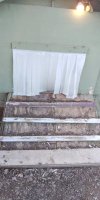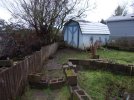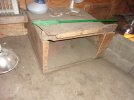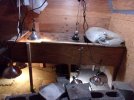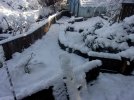Hello,
In the spirit of my previous thread planning an indoor enclosure:
 tortoiseforum.org
tortoiseforum.org
It's been 5 years since Vladimir moved into that enclosure, and it's clear he's outgrown it now. I'm hoping to buy/build a shed to convert to an appropriate winter enclosure for him and would appreciate any advice or suggestions for the project. I plan to update this as things progress (and come back with more questions!)
Some background information - the existing enclosure (indoors) is 8 foot x 16 foot. There are few large flat sections of land on the property on which to build the shed, so it's likely that the shed will also be 8 foot x 16 foot. I'm hoping that by having a door that he can use to go in and out on his own (and check the weather) will allow him to be more comfortable in that same size enclosure. This is being constructed in Pennsylvania, and I hope to be able to maintain 70-80F within the shed if the temperature drops to below 20F.
I'm thinking of something like this if I get something prebuilt:
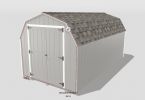
Preparing the Site
I'm guessing the best base for it is a proper gravel pad. I plan to find a contractor to do this work. Is there anything special I need to know?
Insulation
What's the best way to insulate the shed for tortoise occupancy? I was considering using spray foam insulation, assuming that would provide the most complete coverage. I know the tortoise can't be allowed access to the harden spray foam insulation, so I'm considering putting plywood along the walls for the first 3 feet or so to hide the spray foam insulation from tortoise destruction. If we don't use spray foam, I'm guessing the next best way would be to use the rigid foam insulation used in Tom's nightboxes, and cover everything with plywood and seal it?
What about insulating the ceiling? and how should ventilation be handled? Most of the shed models I've seen have some sort of ventilation component.
How about insulating the floors? If I have a shed delivered I don't believe I'd be able to insulate underneath the floor, so I might need to add a layer of insulation on top of the floor and add another layer of plywood?
What do I need to know about vapor barriers?
Tortoise Customizations
Assuming I have a prebuilt shed delivered, it will need to be modified to install a tortoise door. The 18" x 26" door in Vlad's current boxes is clearly not going to be large enough - how big should I go? @Turtulas-Len how large is the door for Walker's home?
Electricity
I'm planning to have an electrician wire everything up. I'd like to have multiple oil filled radiators inside, on separate circuits in case the breaker trips, hopefully it would be a fail-safe to prevent all heat from turning off. I'm also planning on installing UV lights, flood lights, and a Kane mat / RHP area inside.
Roof
Is there any pros/cons to a shingle roof vs a metal roof?
I'm sure I have more questions, but this is a start
In the spirit of my previous thread planning an indoor enclosure:
Planning new indoor enclosure
I figured I'd start my own thread because I'm sure I will have tons of questions. Vladimir is going on 3 years old now and is outgrowing his current indoor enclosure, a 300 gallon rubbermaid stock tank. I'd like to build him a permanent indoor enclosure in a spare room, and we're fortunate to...
It's been 5 years since Vladimir moved into that enclosure, and it's clear he's outgrown it now. I'm hoping to buy/build a shed to convert to an appropriate winter enclosure for him and would appreciate any advice or suggestions for the project. I plan to update this as things progress (and come back with more questions!)
Some background information - the existing enclosure (indoors) is 8 foot x 16 foot. There are few large flat sections of land on the property on which to build the shed, so it's likely that the shed will also be 8 foot x 16 foot. I'm hoping that by having a door that he can use to go in and out on his own (and check the weather) will allow him to be more comfortable in that same size enclosure. This is being constructed in Pennsylvania, and I hope to be able to maintain 70-80F within the shed if the temperature drops to below 20F.
I'm thinking of something like this if I get something prebuilt:

Preparing the Site
I'm guessing the best base for it is a proper gravel pad. I plan to find a contractor to do this work. Is there anything special I need to know?
Insulation
What's the best way to insulate the shed for tortoise occupancy? I was considering using spray foam insulation, assuming that would provide the most complete coverage. I know the tortoise can't be allowed access to the harden spray foam insulation, so I'm considering putting plywood along the walls for the first 3 feet or so to hide the spray foam insulation from tortoise destruction. If we don't use spray foam, I'm guessing the next best way would be to use the rigid foam insulation used in Tom's nightboxes, and cover everything with plywood and seal it?
What about insulating the ceiling? and how should ventilation be handled? Most of the shed models I've seen have some sort of ventilation component.
How about insulating the floors? If I have a shed delivered I don't believe I'd be able to insulate underneath the floor, so I might need to add a layer of insulation on top of the floor and add another layer of plywood?
What do I need to know about vapor barriers?
Tortoise Customizations
Assuming I have a prebuilt shed delivered, it will need to be modified to install a tortoise door. The 18" x 26" door in Vlad's current boxes is clearly not going to be large enough - how big should I go? @Turtulas-Len how large is the door for Walker's home?
Electricity
I'm planning to have an electrician wire everything up. I'd like to have multiple oil filled radiators inside, on separate circuits in case the breaker trips, hopefully it would be a fail-safe to prevent all heat from turning off. I'm also planning on installing UV lights, flood lights, and a Kane mat / RHP area inside.
Roof
Is there any pros/cons to a shingle roof vs a metal roof?
I'm sure I have more questions, but this is a start
